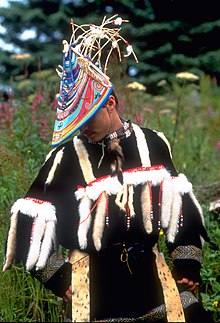யுபிக் மக்கள்
யுபிக் மக்கள் (Yupik) வட துருவப்பகுதியில், ஐக்கிய அமெரிக்காவின் அலாஸ்கா பகுதியின் மேற்கிலும், தென்மேற்கிலும், தென்மத்தியிலும் மற்றும் ருசியாவின் தூரக் கிழக்கின் சைபீரியா பகுதிகளில் வாழும் ஒரு பண்டைய பழங்குடி இனக்குழுவினர் ஆவார். இவர்களை மேற்கு எஸ்கிமோக்கள் என்றும் அழைப்பர். [1]யுபிக் மக்கள், எஸ்கிமோ மற்றும் இனுவிட்டு மக்களுடன் தொடர்புடையவர்கள்.
 முகமூடி அணிந்த யுபிக் மனிதன் | |
| மொத்த மக்கள்தொகை | |
|---|---|
| 35,700 | |
| குறிப்பிடத்தக்க மக்கள்தொகை கொண்ட பகுதிகள் | |
| 34,000 | |
| 1,700 | |
| மொழி(கள்) | |
| யுபிக் மொழி மற்றும் ஆங்கிலம், (அலாஸ்கா), ருசிய மொழி (சைபீரியா | |
| சமயங்கள் | |
| கிறித்தவம், ஆவி வழிபாடு மற்றும் இறைமறுப்பு | |
| தொடர்புள்ள இனக்குழுக்கள் | |
| இனுவிட்டு மற்றும் எஸ்கிமோ | |



மக்கள் தொகையியல்
தொகுஐக்கிய அமெரிக்காவின் 2001ஆம் ஆண்டு மக்கள் தொகை கணக்கெடுப்பின் படி, அமெரிக்க யுபிக் மக்கள் தொகை 24,000 எனக் கணக்கிடப்பட்டுள்ளது.[2] ருசியாவின் சைபீரியப் பகுதியின் யுபிக் மக்கள் தொகை 1,700 ஆக கணக்கிடப்பட்டுள்ளது.[3] யுபிக் மக்கள் யுபிக் மொழி, ஆங்கிலம் மற்றும் ருசிய மொழி பேசுகின்றனர்.
பண்பாடு
தொகுகோடைக்காலத்திலும், வசந்த காலத்திலும் வட துருவப் பகுதிகளில் கடல் சிங்கம் மற்றும் சாலமன் மீன்களை வேட்டையாடி உண்ணும் யுபிக் மக்கள், குளிர் காலத்தில் ஆண்களும், பெண்களும் கூட்டமாக தனித்தனி குடியிருப்புகளில் வாழ்கின்றனர்.
குளிர்காலத்தில் சிறுவர்களுக்கு வேட்டைப் பயிற்சி, வேட்டை கருவிகளை கையாளுதல் வலை பின்னுதல், தோலாடை தயாரித்தல் போன்ற பயிற்சிகளும்; சிறுமிகளுக்கும் சமைத்தல், வலைபின்னுதல், தைத்தல் போன்ற பயிற்சிகள் வழங்கப்படுகிறது.
மேலும் குளிர்காலத்தில் முகமூடி அணிந்து நடனம் ஆடுதல், கதை சொல்லுதல் மற்றும் தங்களுக்கான பண்டிகைகள் மற்றும் விழாக்கள் எடுக்கின்றனர்.
இதனையும் காண்க
தொகுமேற்கோள்கள்
தொகு- ↑ Yupik
- ↑ U.S. Census Bureau. (2004-06-30). "Table 1. American Indian and Alaska Native Alone and Alone or in Combination Population by Tribe for the United States: 2000." American Indian and Alaska Native Tribes for the United States, Regions, Divisions, and States (PHC-T-18). U.S. Census Bureau, Census 2000, special tabulation. Retrieved on 2007-04-12.
- ↑ "Yup’ik." U*X*L Encyclopedia of Native American Tribes. U*X*L. 2008. Retrieved August 14, 2012 from HighBeam Research: http://www.highbeam.com/doc/1G2-3048800051.html பரணிடப்பட்டது 2013-05-15 at the வந்தவழி இயந்திரம்
மேல் வாசிப்பிற்கு
தொகு- Barker, James H. (1993). Always Getting Ready — Upterrlainarluta: Yup'ik Eskimo Subsistence in Southwest Alaska. Seattle, WA: University of Washington Press.
- Branson, John and Tim Troll, eds. (2006). Our Story: Readings from Southwest Alaska — An Anthology. Anchorage, AK: Alaska Natural History Association.
- Federal Field Committee for Development Planning in Alaska. (1968). Alaska Natives & The Land. Washington, DC: U.S. Government Printing Office.
- Campbell, Lyle. (1997). American Indian languages: The historical linguistics of Native America. New York: Oxford University Press. பன்னாட்டுத் தரப்புத்தக எண் 0-19-509427-1.
- Fienup-Riordan, Ann. (1983). The Nelson Island Eskimo: Social Structure and Ritual Distribution. Anchorage, AK: Alaska Pacific University Press.
- Fienup-Riordan, Ann. (1990). Eskimo Essays: Yup'ik Lives and How We See Them. New Brunswick, NJ: Rutgers University Press.
- Fienup-Riordan, Ann. (1991). The Real People and the Children of Thunder: The Yup'ik Eskimo Encounter With Moravian Missionaries John and Edith Kilbuck. Norman, OK: University of Oklahoma Press.
- Fienup-Riordan, Ann. (1994). Boundaries and Passages: Rule and Ritual in Yup'ik Eskimo Oral Tradition. Norman, OK: University of Oklahoma Press.
- Fienup-Riordan, Ann. (1996). The Living Tradition of Yup'ik Masks: Agayuliyararput (Our Way of Making Prayer). Seattle, WA: University of Washington Press.
- Fienup-Riordan, Ann. (2000). Hunting Tradition in a Changing World: Yup'ik Lives in Alaska Today. New Brunswick, NJ: Rutgers University Press.
- Fienup-Riordan, Ann. (2001). What's in a Name? Becoming a Real Person in a Yup'ik Community. University of Nebraska Press.
- Jacobson, Steven A., compiler. (1984). Yup'ik Eskimo Dictionary. Fairbanks, AK: Alaska Native Language Center, University of Alaska Fairbanks.
- Jacobson, Steven A. "Central Yup’ik and the Schools: A Handbook for Teachers." Juneau: Alaska Native Language Center, 1984.
- Kizzia, Tom. (1991). The Wake of the Unseen Object: Among the Native Cultures of Bush Alaska. New York: Henry Holt and Company.
- MacLean, Edna Ahgeak. “Culture and Change for Iñupiat and Yupiks of Alaska.” 2004. Alaska. 12 Nov 2008 <https://web.archive.org/web/20100224195249/http://www.liu.edu/CWIS/CWP/library/workshop/citmla.htm>.
- Mithun, Marianne. (1999). The languages of Native North America. Cambridge: Cambridge University Press. பன்னாட்டுத் தரப்புத்தக எண் 0-521-23228-7 (hbk); பன்னாட்டுத் தரப்புத்தக எண் 0-521-29875-X.
- Morgan, Lael, ed. (1979). Alaska's Native People. Alaska Geographic 6(3). Alaska Geographic Society.
- Naske, Claus-M. and Herman E. Slotnick. (1987). Alaska: A History of the 49th State, 2nd edition. Norman, OK: University of Oklahoma Press.
- Oswalt, Wendell H. (1967). Alaskan Eskimos. Scranton, PA: Chandler Publishing Company.
- Oswalt, Wendell H. (1990). Bashful No Longer: An Alaskan Eskimo Ethnohistory, 1778–1988. Norman, OK: University of Oklahoma Press.
- Pete, Mary. (1993). "Coming to Terms." In Barker, 1993, pp. 8–10.
- Reed, Irene, et al. Yup’ik Eskimo Grammar. Alaska: U of Alaska, 1977.
- de Reuse, Willem J. (1994). Siberian Yupik Eskimo: The language and its contacts with Chukchi. Studies in indigenous languages of the Americas. Salt Lake City: University of Utah Press. பன்னாட்டுத் தரப்புத்தக எண் 0-87480-397-7.
வெளி இணைப்புகள்
தொகு- Alaska Native Language Center
- Genealogical tree பரணிடப்பட்டது 2017-09-02 at the வந்தவழி இயந்திரம்
- the distribution map of Yupik languages.
- Project Naming பரணிடப்பட்டது 2006-10-28 at the வந்தவழி இயந்திரம், the identification of Inuit portrayed in photographic collections at Library and Archives Canada